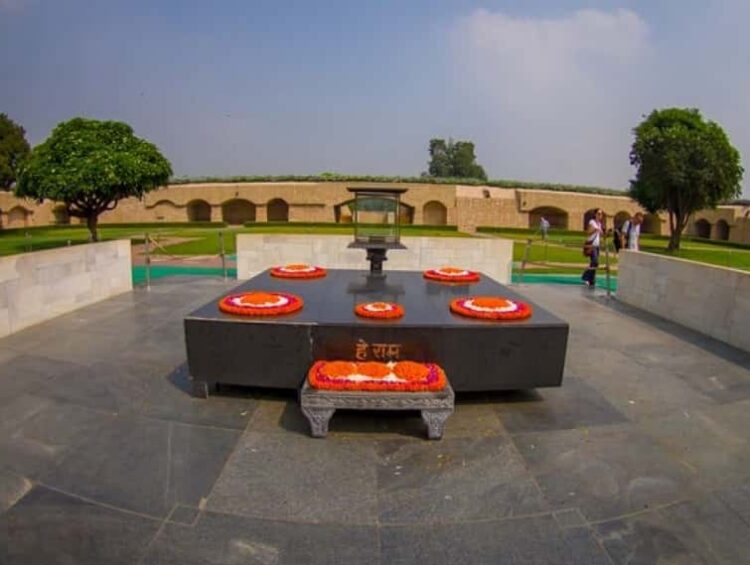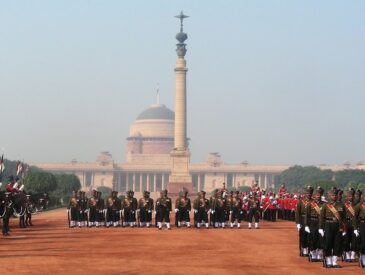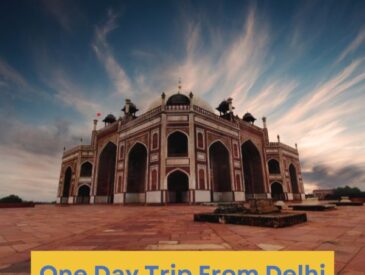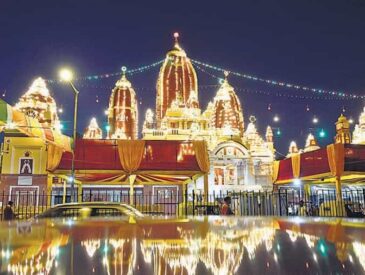Raj Ghat in Delhi stands as a profound symbol of India’s journey toward freedom and embodies the timeless values of Mahatma Gandhi. Situated on the banks of the Yamuna River, Raj Ghat is not only a memorial but also a sanctuary of peace and reflection, drawing people from all walks of life to pay homage to one of history’s most influential leaders.
- Location: Mahatma Gandhi Marg (Ring Road), New Delhi, on the banks of the Yamuna River.
- Dedicated to: Mahatma Gandhi, marking the spot where he was cremated on January 31, 1948.
- Design: Simple black marble platform inscribed with “Hey Ram” (Gandhi’s last words).
- Architect: Vanu G. Bhuta; landscaping by Alick Percy-Lancaster.
- Features:
- Eternal flame symbolizing Gandhi’s enduring legacy.
- Surrounded by lush gardens with trees planted by world dignitaries.
- Entry: Free for all; open daily from 6:30 am to 6:00 pm.
- Nearby Attractions: Red Fort, Jama Masjid, India Gate, and Connaught Place.
- Additional Memorials: Nearby memorials for other leaders like Jawaharlal Nehru (Shantivan) and Indira Gandhi (Shakti Sthal).
- Museum: National Gandhi Museum nearby, showcasing artifacts, books, and memorabilia related to Gandhi’s life.
- Events: Special prayer meetings on Gandhi’s birth and death anniversaries; regular prayer sessions on Fridays.
Introduction to Raj Ghat: A Landmark of National Significance
Raj Ghat is a national memorial dedicated to Mahatma Gandhi, who is affectionately called the Father of the Nation in India. Gandhi’s ideology and methods shaped the Indian independence movement and inspired leaders worldwide. True to Gandhi’s principles of simplicity and humility, Raj Ghat is a modest structure without extravagant embellishments, a testament to his life philosophy.
The Raj Ghat complex not only commemorates Gandhi but also serves as a broader tribute to other prominent Indian leaders. Today, the serene environs of Raj Ghat attract not only Indian nationals but also foreign tourists, dignitaries, and delegates who come to pay their respects to Gandhi and the legacy he left behind.
- Suggested Tour: Most Popular Tourist Places to Visit in Delhi
History of Raj Ghat: From a Cremation Site to a Memorial
The word “Raj Ghat” originally referred to a gate in the walled city of Shahjahanabad (Old Delhi) that opened on the western banks of the Yamuna River. Following the assassination of Mahatma Gandhi on January 30, 1948, his body was brought to a spot near this area for cremation. The location became hallowed ground as millions of Indians mourned their leader.
The following day, January 31, 1948, Gandhi’s body was cremated at this site, which soon transformed into a pilgrimage for those wanting to honor his life. A simple black marble platform now marks the exact spot where he was consigned to flames, engraved with the words “Hey Ram,” Gandhi’s last words.
- Suggested Tour: Delhi Tour Packages
Architecture and Design: A Reflection of Gandhi’s Simplicity
The memorial at Raj Ghat was designed by Vanu G. Bhuta, who chose to craft a minimalist square platform in black marble, devoid of any ornate features or decorations. The structure’s simplicity is its essence, embodying the principles of simplicity and spiritual strength that Gandhi stood for.
- Platform Dimensions: The black marble platform is a 12 x 12 feet square, elevated slightly at 2 feet from the ground. This unobtrusive design creates a quiet, reverent atmosphere, allowing visitors to focus on Gandhi’s values.
- Inscription: The words “Hey Ram” inscribed on the marble platform are believed to be the last words spoken by Gandhi before he succumbed to his wounds. The phrase means “Oh God,” symbolizing Gandhi’s spiritual mindset and his dedication to peaceful resistance.
- Eternal Flame: An eternal flame in a glass enclosure rests on the platform, representing Gandhi’s lasting influence on the world. The flame is kept burning around the clock, symbolizing his undying legacy.
The memorial is surrounded by a walled enclosure with a stone-paved pathway, leading to a peaceful garden and extensive lawns. Alick Percy-Lancaster, a prominent British horticulturist, designed the landscaping, further enhancing the area’s serene ambiance.
Garden and Dignitaries’ Trees: A Symbol of Global Respect
The garden around the Raj Ghat memorial includes trees planted by influential world leaders, symbolizing global respect and admiration for Mahatma Gandhi. Each tree is labeled with the name of the dignitary who planted it, creating a unique international tribute to Gandhi’s legacy. Notable figures who have planted trees include:
- Queen Elizabeth II
- Ho Chi Minh (Vietnamese leader)
- Dwight D. Eisenhower (former U.S. President)
- Yuri Gagarin (Russian cosmonaut)
These symbolic acts of tree planting highlight the universal values of peace, unity, and resilience that Gandhi represented.
National Gandhi Museum: Preserving Gandhian Ideology
In the vicinity of Raj Ghat lies the National Gandhi Museum (also known as Gandhi Memorial Museum), dedicated to preserving and promoting the life and ideals of Mahatma Gandhi. The museum showcases an extensive collection of artifacts, writings, and memorabilia associated with Gandhi’s life, providing visitors a chance to delve deeper into his philosophies and achievements.
Highlights of the Museum Collection:
- Artifacts: Personal items like Gandhi’s dhoti, shawl, walking sticks, and even his famous charkhas (spinning wheels) are displayed. The museum also houses some of Gandhi’s teeth and a bullet that was used in his assassination.
- Photographs and Documents: Over 35,000 documents, including letters, books, and articles written by and about Gandhi, are available for study.
- Audio-Visual Section: A 75-seat auditorium shows films on Gandhi’s life and work every Saturday and Sunday from 4:00 pm to 5:00 pm, free of charge.
- Charkha Exhibit: The museum features 23 models of the charkha, representing Gandhi’s emphasis on self-reliance and the revival of Indian industries.
This museum serves as an educational and cultural center, helping visitors gain a deeper understanding of Gandhi’s life and the principles he advocated.
- Check Out: Delhi Museum Tour
Additional Memorials in the Vicinity
The Raj Ghat complex is home to several other memorials for Indian leaders who played key roles in shaping the nation. These additional samadhis honor former Prime Ministers, Presidents, and prominent figures, making Raj Ghat a collective memorial site for Indian statesmanship.
Some of the notable memorials in the area include:
- Vijay Ghat: Commemorates Lal Bahadur Shastri, India’s second Prime Minister, known for his simplicity and integrity.
- Shantivan: Dedicated to Jawaharlal Nehru, India’s first Prime Minister, who laid the foundations for modern India.
- Shakti Sthal: Honors Indira Gandhi, the first woman Prime Minister of India, known for her powerful leadership.
- Veer Bhoomi: Rajiv Gandhi’s memorial, dedicated to a Prime Minister who sought modernization and liberalization.
- Karma Bhumi: A tribute to Shankar Dayal Sharma, a former President of India.
- Rashtriya Smriti Sthal: The most recent addition, dedicated to Atal Bihari Vajpayee, former Prime Minister of India, known for his statesmanship and poetic spirit.
These memorials create an aura of reverence and reflection, turning Raj Ghat into a space that honors India’s rich history and political legacy.
Visitor Experience and Facilities at Raj Ghat
Raj Ghat is designed to offer visitors a peaceful and reflective experience, aligned with Gandhi’s ethos. Entry is free, and the memorial is open to the public daily from 6:30 am to 6:00 pm.
- Entry and Camera Fees: There is no fee for entering the memorial or taking photographs, making it accessible to everyone.
- Guided Tours: While official guided tours are not a feature of Raj Ghat, various private tour companies in Delhi include Raj Ghat as a significant part of their itinerary.
- Prayer Meetings: On Fridays, a prayer meeting is held at Raj Ghat to honor Gandhi’s memory. Additionally, special ceremonies take place on Gandhi’s birth (October 2) and death anniversaries (January 30).
The quiet pathways and lush green lawns provide a suitable environment for meditation and contemplation, encouraging visitors to reflect on the life and teachings of Mahatma Gandhi.
Attractions Nearby Raj Ghat
For visitors exploring Delhi, several important attractions lie within a short distance from Raj Ghat, allowing for a comprehensive historical tour of the city. Some nearby landmarks include:
- Red Fort (2.1 km): A UNESCO World Heritage site, this historic fort built by Emperor Shah Jahan is an architectural marvel.
- Jama Masjid (2.5 km): One of India’s largest mosques, built by Mughal Emperor Shah Jahan.
- India Gate (5.3 km): A war memorial dedicated to Indian soldiers, surrounded by beautiful gardens.
- Connaught Place (4.2 km): A commercial hub with colonial architecture, bustling markets, and restaurants.
- National Museum of Natural History (3.7 km): A museum showcasing the rich natural history of India.
- Jantar Mantar (4.4 km): An astronomical observatory with impressive sundials and other instruments.
- Rashtrapati Bhavan (6.8 km): The official residence of the President of India, with sprawling gardens open to the public.
These attractions provide an opportunity for visitors to experience Delhi’s historical, cultural, and architectural grandeur.
The Legacy of Raj Ghat: A Living Memorial
Raj Ghat transcends its role as a simple memorial by continuing to inspire people worldwide with Gandhi’s legacy. It remains a site of international importance, drawing numerous dignitaries and leaders who pay homage to Gandhi and reaffirm their commitment to peace and nonviolence. In a world facing new challenges, Gandhi’s principles of truth, nonviolence, and sustainable living resonate strongly.
Every year on Gandhi’s birth anniversary, October 2, which is celebrated as Gandhi Jayanti, the Raj Ghat sees large gatherings and prayer services attended by prominent figures and citizens alike. This celebration of Gandhi’s life and message ensures that his teachings remain relevant and respected.
Conclusion
Raj Ghat is more than just a memorial; it is a symbol of India’s spirit and dedication to the ideals of peace, freedom, and human dignity. Visiting Raj Ghat offers a glimpse into the life of a leader who shaped the destiny of a nation and inspired millions around the globe. For anyone visiting Delhi, Raj Ghat is a must-visit destination, providing both a historical perspective and a tranquil space to reflect on the enduring legacy of Mahatma Gandhi.







